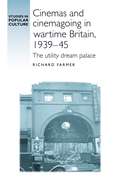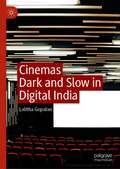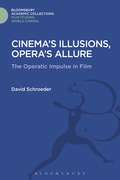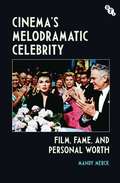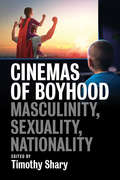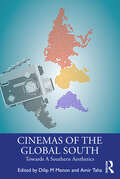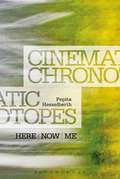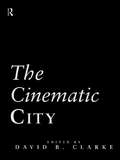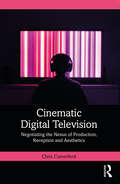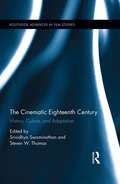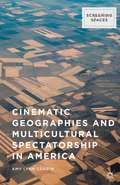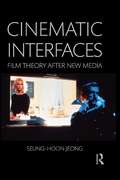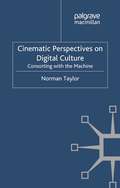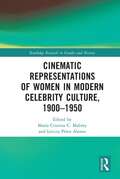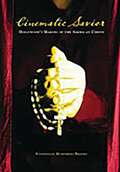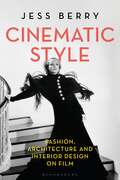- Table View
- List View
Cinemas and cinemagoing in wartime Britain, 1939–45: The utility dream palace (G - Reference, Information and Interdisciplinary Subjects)
by Richard FarmerDuring the Second World War, the popularity and importance of the cinema in Britain was at its peak. In this groundbreaking book, Richard Farmer provides a social and cultural history of cinemas and cinemagoing in Britain between 1939 and 1945, and explores the impact that the war had on the places in which British people watched films. Although promising the possibility of escape from the hardships and terrors of wartime life, the cinema was so intimately woven into the fabric of British society that it could not itself escape the war. Drawing on a wealth of contemporary sources, and on the memories of wartime cinemagoers, Cinemagoing in wartime Britain, 1939-45 is the first book to offer an in-depth exploration of the impact that phenomena such as the black out, the blitz, food rationing, evacuation and conscription had on both the exhibition industry and the experiences of the picturegoers themselves.
Cinemas and cinemagoing in wartime Britain, 1939–45: The utility dream palace (Studies in Popular Culture)
by Richard FarmerDuring the Second World War, the popularity and importance of the cinema in Britain was at its peak. In this groundbreaking book, Richard Farmer provides a social and cultural history of cinemas and cinemagoing in Britain between 1939 and 1945, and explores the impact that the war had on the places in which British people watched films. Although promising the possibility of escape from the hardships and terrors of wartime life, the cinema was so intimately woven into the fabric of British society that it could not itself escape the war. Drawing on a wealth of contemporary sources, and on the memories of wartime cinemagoers, Cinemagoing in wartime Britain, 1939-45 is the first book to offer an in-depth exploration of the impact that phenomena such as the black out, the blitz, food rationing, evacuation and conscription had on both the exhibition industry and the experiences of the picturegoers themselves.
Cinemas Dark and Slow in Digital India
by Lalitha GopalanThis book provides a sustained engagement with contemporary Indian feature films from outside the mainstream, including Aaranaya Kaandam, I.D., Kaul, Chauthi Koot, Cosmic Sex, and Gaali Beeja, to undercut the dominance of Bollywood focused film studies. Gopalan assembles films from Bangalore, Chennai, Delhi, Kolkata, and Trivandrum, in addition to independent productions in Bombay cinema, as a way of privileging understudied works that deserve critical attention. The book uses close readings of films and a deep investigation of film style to draw attention to the advent of digital technologies while remaining fully cognizant of ‘the digital’ as a cryptic formulation for considering the sea change in the global circulation of film and finance. This dual focus on both the techno-material conditions of Indian cinema and the film narrative offers a fulsome picture of changing narratives and shifting genres and styles.
Cinema's Illusions, Opera's Allure: The Operatic Impulse in Film (Film Studies: Bloomsbury Academic Collections)
by David SchroederThe invention of cinema was ingenious, so much so that virtually no-one quite knew what to do with it. In its earliest stages, especially with the advent of the feature film, it needed models, and opera proved to be especially useful in that regard. The allure of opera to cinema early in the twentieth century held up through the silent era, into sound films, through the golden age of movies, and beyond. This book explores the numerous ways – some predictable, some unexpected, and some bizarre – in which this has happened. The influence of Richard Wagner on filmmakers has been especially striking, and some have even devised visual images that seem to emerge from a kind of non-verbal Wagnerian essence – a formative, musical urge that can underlie a cinematic idea, defying explanation and remaining purely sensory. Directors like Griffith, DeMille, Eisenstein, Chaplin, Bunuel or Hitchcock have intuited this possibility. Schroeder provides a fascinating, well-researched and always entertaining account of the influence of one medium on another, and shows that opera can often be found lurking in the background (or booming in the foreground) of an impressive range of films.
Cinema's Melodramatic Celebrity: Film, Fame, and Personal Worth
by Mandy MerckChallenging the study of both celebrity and the cinema, Mandy Merck argues that modern fame and film melodrama are part of the same worldview, one that cannot resolve the relation of personal worth to social esteem. Tracing the history of this conundrum back to the philosophy of the seventeenth century and the theatre of the eighteenth, she demonstrates its convergence in stage melodrama and its intensification in the Hollywood star system. Are today's celebrities worth our attention? In that demand for judgement and the hope for its visual guidance, the melodramatic imagination survives – permeating not only fiction film, but documentary, the artist's film, and our self-exhibition on social media.Examining a range of classical and contemporary films from Charlie Chaplin's City Lights (1931) to Laura Poitras's Citizenfour (2014) , the many remakes of A Star Is Born, the compulsory exhibitionism of political celebrity and the unmasking of whistle-blowers, Merck illustrates the ways in which the cinema constantly restages the moral evaluation of prominent individuals, whether they are actors, artists, politicians or activists.
Cinema's Melodramatic Celebrity: Film, Fame, and Personal Worth
by Mandy MerckChallenging the study of both celebrity and the cinema, Mandy Merck argues that modern fame and film melodrama are part of the same worldview, one that cannot resolve the relation of personal worth to social esteem. Tracing the history of this conundrum back to the philosophy of the seventeenth century and the theatre of the eighteenth, she demonstrates its convergence in stage melodrama and its intensification in the Hollywood star system. Are today's celebrities worth our attention? In that demand for judgement and the hope for its visual guidance, the melodramatic imagination survives – permeating not only fiction film, but documentary, the artist's film, and our self-exhibition on social media.Examining a range of classical and contemporary films from Charlie Chaplin's City Lights (1931) to Laura Poitras's Citizenfour (2014) , the many remakes of A Star Is Born, the compulsory exhibitionism of political celebrity and the unmasking of whistle-blowers, Merck illustrates the ways in which the cinema constantly restages the moral evaluation of prominent individuals, whether they are actors, artists, politicians or activists.
Cinemas of Boyhood: Masculinity, Sexuality, Nationality
by Timothy SharyDrawing from political sociology, pop psychology, and film studies, Cinemas of Boyhood explores the important yet often overlooked subject of boys and boyhood in film. This collected volume features an eclectic range of films from British and Indian cinemas to silent Hollywood and the new Hollywood of the 1980s, culminating in a comprehensive overview of the diverse concerns surrounding representations of boyhood in film.
Cinemas of the Global South: Towards a Southern Aesthetics
by Dilip M Menon Amir TahaThis book engages with the idea of the Global South through cinema as a concept of resistance; as a space of decolonialisation; and as an arena of virtuality, creativity and change. It opens up a dialogue amongst scholars and filmmakers from the Global South: India, Nigeria, Colombia, Brazil, South Africa, and Egypt.The essays in the volume approach cinema as an intertwined process of both production and perception not divorced from the economic, social, political and cultural. They emphasise film as a visual medium where form, structure and content are not separable. Through a wide array of film-readings, the authors explore the concept of a southern cinematic esthetics, in particular, and the concept of the Global South in general.The volume will be of interest to scholars, students and researchers of film and media studies, critical theory, cultural studies and Global South studies.
Cinemas of the Global South: Towards a Southern Aesthetics
This book engages with the idea of the Global South through cinema as a concept of resistance; as a space of decolonialisation; and as an arena of virtuality, creativity and change. It opens up a dialogue amongst scholars and filmmakers from the Global South: India, Nigeria, Colombia, Brazil, South Africa, and Egypt.The essays in the volume approach cinema as an intertwined process of both production and perception not divorced from the economic, social, political and cultural. They emphasise film as a visual medium where form, structure and content are not separable. Through a wide array of film-readings, the authors explore the concept of a southern cinematic esthetics, in particular, and the concept of the Global South in general.The volume will be of interest to scholars, students and researchers of film and media studies, critical theory, cultural studies and Global South studies.
Cinematic Chronotopes: Here, Now, Me
by Pepita HesselberthThe site of cinema is on the move. The extent to which technologically mediated sounds and images continue to be experienced as cinematic today is largely dependent on the intensified sense of being 'here,' 'now' and 'me' that they convey. This intensification is fundamentally rooted in the cinematic's potential to intensify our experience of time, to convey time's thickening, of which the sense of place, and a sense of self-presence are the correlatives. In this study, Pepita Hesselberth traces this thickening of time across four different spatio-temporal configurations of the cinematic: a multi-media exhibition featuring the work of Andy Warhol (1928-1987); the handheld aesthetics of European art-house films; a large-scale media installation by Rafael Lozano-Hemmer; and the usage of the trope of the flash-forward in mainstream Hollywood cinema. Only by juxtaposing these cases by looking at what they have in common, this study argues, can we grasp the complexity of the changes that the cinematic is currently undergoing.
Cinematic Chronotopes: Here, Now, Me
by Pepita HesselberthThe site of cinema is on the move. The extent to which technologically mediated sounds and images continue to be experienced as cinematic today is largely dependent on the intensified sense of being 'here,' 'now' and 'me' that they convey. This intensification is fundamentally rooted in the cinematic's potential to intensify our experience of time, to convey time's thickening, of which the sense of place, and a sense of self-presence are the correlatives. In this study, Pepita Hesselberth traces this thickening of time across four different spatio-temporal configurations of the cinematic: a multi-media exhibition featuring the work of Andy Warhol (1928-1987); the handheld aesthetics of European art-house films; a large-scale media installation by Rafael Lozano-Hemmer; and the usage of the trope of the flash-forward in mainstream Hollywood cinema. Only by juxtaposing these cases by looking at what they have in common, this study argues, can we grasp the complexity of the changes that the cinematic is currently undergoing.
The Cinematic City
by David ClarkeThe Cinematic City offers an innovative and thought-provoking insight into cityscape and screenscape and their inter-connection. Illustrated throughout with movie stills, a diverse selection of films (from 'Bladerunner' to 'Little Caesar'), genres, cities and historical periods are examined by leading names in the field. The key dimensions of film and urban theory are introduced before detailed analysis of the various cinematic forms which relate most significantly to the city. From early cinema and documentary film, to film noir, 'New Wave' and 'postmodern cinema', the contributors provide a wealth of empirical material and illustration whilst drawing on the theoretical insights of contemporary feminism, Benjamin, Baudrillard, Foucault, Lacan, and others. The Cinematic City shows how the city has been undeniably shaped by the cinematic form, and how cinema owes much of its nature to the historical development of urban space. Engaging with current theoretical debates, this is a book that is set to change the way in which we think about both the nature of the city and film. Contributors: Giuliana Bruno, Iain Chambers, Marcus Doel, David Clarke, Anthony Easthope, Elisabeth Mahoney, Will Straw, Stephen Ward, John Gold, James Hay, Rob Lapsley, Frank Krutnik
The Cinematic City
by David B. ClarkeThe Cinematic City offers an innovative and thought-provoking insight into cityscape and screenscape and their inter-connection. Illustrated throughout with movie stills, a diverse selection of films (from 'Bladerunner' to 'Little Caesar'), genres, cities and historical periods are examined by leading names in the field. The key dimensions of film and urban theory are introduced before detailed analysis of the various cinematic forms which relate most significantly to the city. From early cinema and documentary film, to film noir, 'New Wave' and 'postmodern cinema', the contributors provide a wealth of empirical material and illustration whilst drawing on the theoretical insights of contemporary feminism, Benjamin, Baudrillard, Foucault, Lacan, and others. The Cinematic City shows how the city has been undeniably shaped by the cinematic form, and how cinema owes much of its nature to the historical development of urban space. Engaging with current theoretical debates, this is a book that is set to change the way in which we think about both the nature of the city and film. Contributors: Giuliana Bruno, Iain Chambers, Marcus Doel, David Clarke, Anthony Easthope, Elisabeth Mahoney, Will Straw, Stephen Ward, John Gold, James Hay, Rob Lapsley, Frank Krutnik
Cinematic Digital Television: Negotiating the Nexus of Production, Reception and Aesthetics
by Chris ComerfordChris Comerford explores cinematic digital television as an artistic classification and an academic object of study, and illuminates the slippage in definitions of previously understood media forms. The growth of television as an artistic, informative medium has given rise to shifts in the aesthetic style of the programmes we watch, and this book outlines these shifts along with the contemporary debates and critical theory surrounding them. Comerford looks at the forms and aesthetics of television, the production standards influencing streaming television and the agency of audiences, and provides case studies of key TV shows illustrating these shifts, including Twin Peaks: The Return, WandaVision, Hacks and Russian Doll. Navigating the levels of production and reception in cinematic digital television, the book uses film-inspired TV as a lightning rod for understanding our narrative screen media landscape and the classifications we use to negotiate it. As an essential reading for both scholars and students of media and television studies, this book provides a much-needed consideration of the changing landscape of television.
Cinematic Digital Television: Negotiating the Nexus of Production, Reception and Aesthetics
by Chris ComerfordChris Comerford explores cinematic digital television as an artistic classification and an academic object of study, and illuminates the slippage in definitions of previously understood media forms. The growth of television as an artistic, informative medium has given rise to shifts in the aesthetic style of the programmes we watch, and this book outlines these shifts along with the contemporary debates and critical theory surrounding them. Comerford looks at the forms and aesthetics of television, the production standards influencing streaming television and the agency of audiences, and provides case studies of key TV shows illustrating these shifts, including Twin Peaks: The Return, WandaVision, Hacks and Russian Doll. Navigating the levels of production and reception in cinematic digital television, the book uses film-inspired TV as a lightning rod for understanding our narrative screen media landscape and the classifications we use to negotiate it. As an essential reading for both scholars and students of media and television studies, this book provides a much-needed consideration of the changing landscape of television.
The Cinematic Eighteenth Century: History, Culture, and Adaptation (Routledge Advances in Film Studies)
by Srividhya Swaminathan Steven W. ThomasThis collection explores how film and television depict the complex and diverse milieu of the eighteenth century as a literary, historical, and cultural space. Topics range from adaptations of Austen’s Sense and Sensibility and Defoe's Robinson Crusoe (The Martian) to historical fiction on the subjects of slavery (Belle), piracy (Crossbones and Black Sails), monarchy (The Madness of King George and The Libertine), print culture (Blackadder and National Treasure), and the role of women (Marie Antoinette, The Duchess, and Outlander). This interdisciplinary collection draws from film theory and literary theory to discuss how film and television allows for critical re-visioning as well as revising of the cultural concepts in literary and extra-literary writing about the historical period.
The Cinematic Eighteenth Century: History, Culture, and Adaptation (Routledge Advances in Film Studies)
by Srividhya Swaminathan Steven W. ThomasThis collection explores how film and television depict the complex and diverse milieu of the eighteenth century as a literary, historical, and cultural space. Topics range from adaptations of Austen’s Sense and Sensibility and Defoe's Robinson Crusoe (The Martian) to historical fiction on the subjects of slavery (Belle), piracy (Crossbones and Black Sails), monarchy (The Madness of King George and The Libertine), print culture (Blackadder and National Treasure), and the role of women (Marie Antoinette, The Duchess, and Outlander). This interdisciplinary collection draws from film theory and literary theory to discuss how film and television allows for critical re-visioning as well as revising of the cultural concepts in literary and extra-literary writing about the historical period.
Cinematic Geographies and Multicultural Spectatorship in America (Screening Spaces)
by Amy Lynn CorbinExploration, intertwined with home-seeking, has always defined America. Corbin argues that films about significant cultural landscapes in America evoke a sense of travel for their viewers. These virtual travel experiences from the mid-1970s through the 1990s built a societal map of "popular multiculturalism" through a movie-going experience.
Cinematic Interfaces: Film Theory After New Media
by Seung-hoon JeongIn this book, Seung-hoon Jeong introduces the cinematic interface as a contact surface that mediates between image and subject, proposing that this mediation be understood not simply as transparent and efficient but rather as asymmetrical, ambivalent, immanent, and multidirectional. Jeong enlists the new media term "interface" to bring to film theory a synthetic notion of interfaciality as underlying the multifaceted nature of both the image and subjectivity. Drawing on a range of films, Jeong examines cinematic interfaces seen on screen and the spectator’s experience of them, including: the direct appearance of a camera/filmstrip/screen, the character’s bodily contact with such a medium-interface, the object’s surface and the subject’s face as "quasi-interface," and the image itself. Each of these case studies serves as a platform for remapping and revamping major concepts in film studies such as suture, embodiment, illusion, signification, and indexicality. Looking to such theories as the ontology of the image and the phenomenology of the body, this original theorization of the cinematic interface not only offers a conceptual framework for rethinking and re-linking film and media studies, but also suggests a general theory of the interface.
Cinematic Interfaces: Film Theory After New Media
by Seung-hoon JeongIn this book, Seung-hoon Jeong introduces the cinematic interface as a contact surface that mediates between image and subject, proposing that this mediation be understood not simply as transparent and efficient but rather as asymmetrical, ambivalent, immanent, and multidirectional. Jeong enlists the new media term "interface" to bring to film theory a synthetic notion of interfaciality as underlying the multifaceted nature of both the image and subjectivity. Drawing on a range of films, Jeong examines cinematic interfaces seen on screen and the spectator’s experience of them, including: the direct appearance of a camera/filmstrip/screen, the character’s bodily contact with such a medium-interface, the object’s surface and the subject’s face as "quasi-interface," and the image itself. Each of these case studies serves as a platform for remapping and revamping major concepts in film studies such as suture, embodiment, illusion, signification, and indexicality. Looking to such theories as the ontology of the image and the phenomenology of the body, this original theorization of the cinematic interface not only offers a conceptual framework for rethinking and re-linking film and media studies, but also suggests a general theory of the interface.
Cinematic Perspectives on Digital Culture: Consorting with the Machine
by Norman TaylorExploring research into mobile phone use as props to subjective identity, Norman Taylor employs concepts from Michelle Foucault, Gilles Deleuze and actor network theory to discuss the affect of mechanisms of make-believe, from celebrity culture to avatar-obsessed game players, and digital culture.
Cinematic Representations of Women in Modern Celebrity Culture, 1900–1950 (Routledge Research in Gender and History #45)
by María Cristina C. Mabrey Leticia Pérez AlonsoThe purpose of this edited volume is to explore the contributions of women to European, Mexican, American and Indian film industries during the years 1900 to 1950, an important period that signified the rise and consolidation of media technologies. Their pioneering work as film stars, writers, directors, designers and producers as well as their endeavors to bridge the gap between the avant-garde and mass culture are significant aspects of this collection. This intersection will be carefully nuanced through their cinematographic production, performances and artistic creations. Other distinctive features pertain to the interconnection of gender roles and moral values with ways of looking, which paves the way for realigning social and aesthetic conventions of femininity. Based on this thematic and diverse sociocultural context, this study has an international scope, their main audiences being scholars and graduate students that pursue to advance interdisciplinary research in the field of feminist theory, film, gender, media and avant-garde studies. Likewise, historians, art and literature specialists will find the content appealing to the degree that intermedial and cross-cultural approaches are presented.
Cinematic Representations of Women in Modern Celebrity Culture, 1900–1950 (Routledge Research in Gender and History #45)
by María Cristina C. Mabrey Leticia Pérez AlonsoThe purpose of this edited volume is to explore the contributions of women to European, Mexican, American and Indian film industries during the years 1900 to 1950, an important period that signified the rise and consolidation of media technologies. Their pioneering work as film stars, writers, directors, designers and producers as well as their endeavors to bridge the gap between the avant-garde and mass culture are significant aspects of this collection. This intersection will be carefully nuanced through their cinematographic production, performances and artistic creations. Other distinctive features pertain to the interconnection of gender roles and moral values with ways of looking, which paves the way for realigning social and aesthetic conventions of femininity. Based on this thematic and diverse sociocultural context, this study has an international scope, their main audiences being scholars and graduate students that pursue to advance interdisciplinary research in the field of feminist theory, film, gender, media and avant-garde studies. Likewise, historians, art and literature specialists will find the content appealing to the degree that intermedial and cross-cultural approaches are presented.
Cinematic Savior: Hollywood's Making of the American Christ
by Stephenson Humphries-BrooksFrom Cecil B. DeMille's production of King of Kings in 1927, to Mel Gibson's recent The Passion of the Christ, films that discuss the meaning of Jesus have provoked interest, discussion, and reevaluation on a large scale. Hollywood films that deal with this subject have consistently managed to augment their inherent power by commenting simultaneously on political and cultural matters, and drawing from alternative cultural and mythological sources. The Greatest Story Ever Told, for instance, uses a landscape similar to that of the American West, while The Last Temptation of Christ deals with themes related to modern American notions of sexuality and sin. This timely examination considers the life of Jesus as it has been portrayed in such films as King of Kings, The Greatest Story Ever Told, Jesus of Nazareth, The Last Temptation of Christ, and The Passion of the Christ, as well as the more allusive and implicit use of Christ-related themes in Spartacus, Shane, and The Matrix. It looks at the diverse content and often-surprising impact of these and other films, and reveals how these depictions have helped determine, and been determined by, particularly American notions of who Jesus was, how he lived and died, and what he means for both our religious and secular cultures.Through an objective consideration of these movies, the emergent religious culture of mainstream American film becomes apparent as a central element in Hollywood movies—and in American popular culture at large.
Cinematic Style: Fashion, Architecture and Interior Design on Film
by Jess BerryFrom cinema's silent beginnings, fashion and interior design have been vital to character development and narrative structure. Despite spectacular technological advancements on screen, stunning silhouettes and striking spaces still have the ability to dazzle to dramatic effect. This book is the first to consider the significant interplay between fashion and interiors and their combined contribution to cinematic style from early film to the digital age.With examples from Frank Lloyd Wright inspired architecture in Hitchcock's North by Northwest, to Coco Chanel's costumes for Gloria Swanson and a Great Gatsby film-set turned Ralph Lauren flagship, Cinematic Style describes the reciprocal relationship between these cultural forms. Exposing the bleeding lines between fashion and interiors in cinematic and real-life contexts, Berry presents case studies of cinematic styles adopted as brand identities and design movements promoted through filmic fantasy.Shedding light on consumer culture, social history and gender politics as well as on fashion, film and interior design theory, Cinematic Style considers the leading roles domestic spaces, quaint cafes, little black dresses and sharp suits have played in 20th and 21st-century film.
